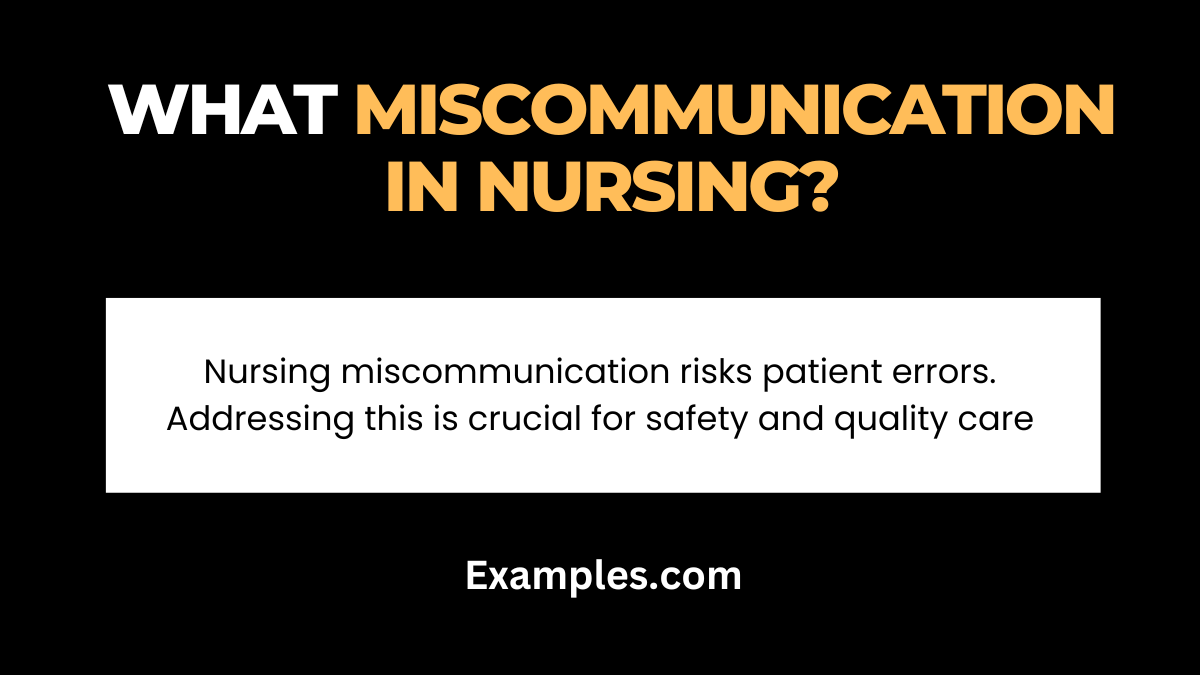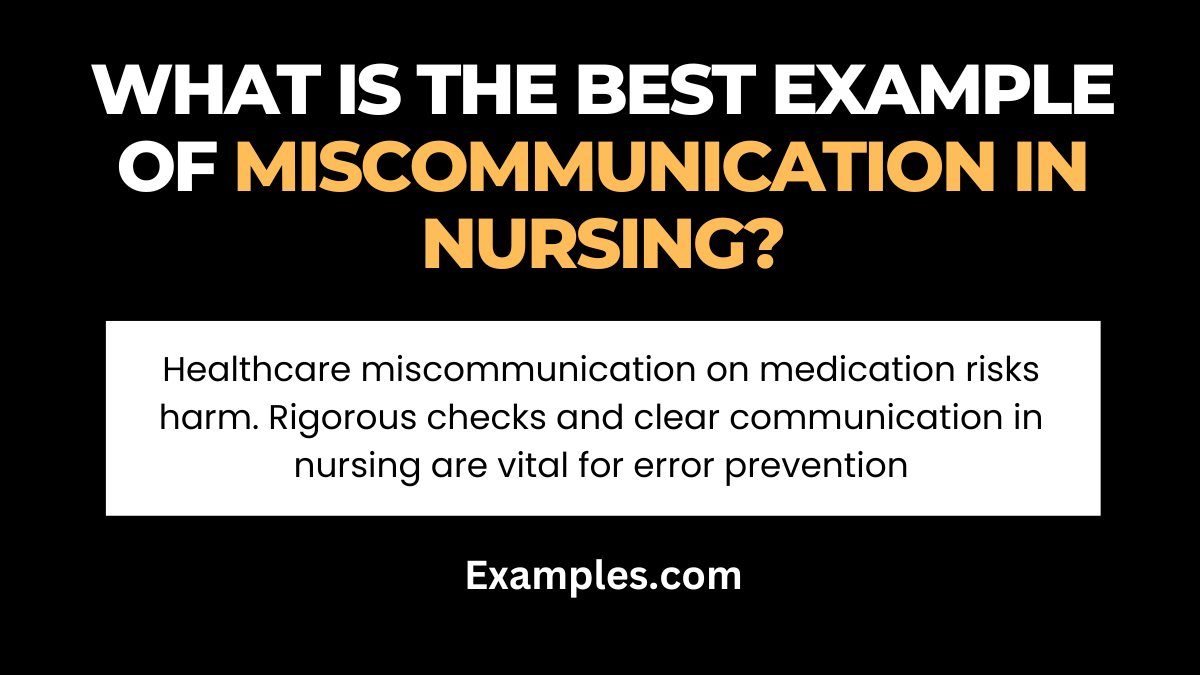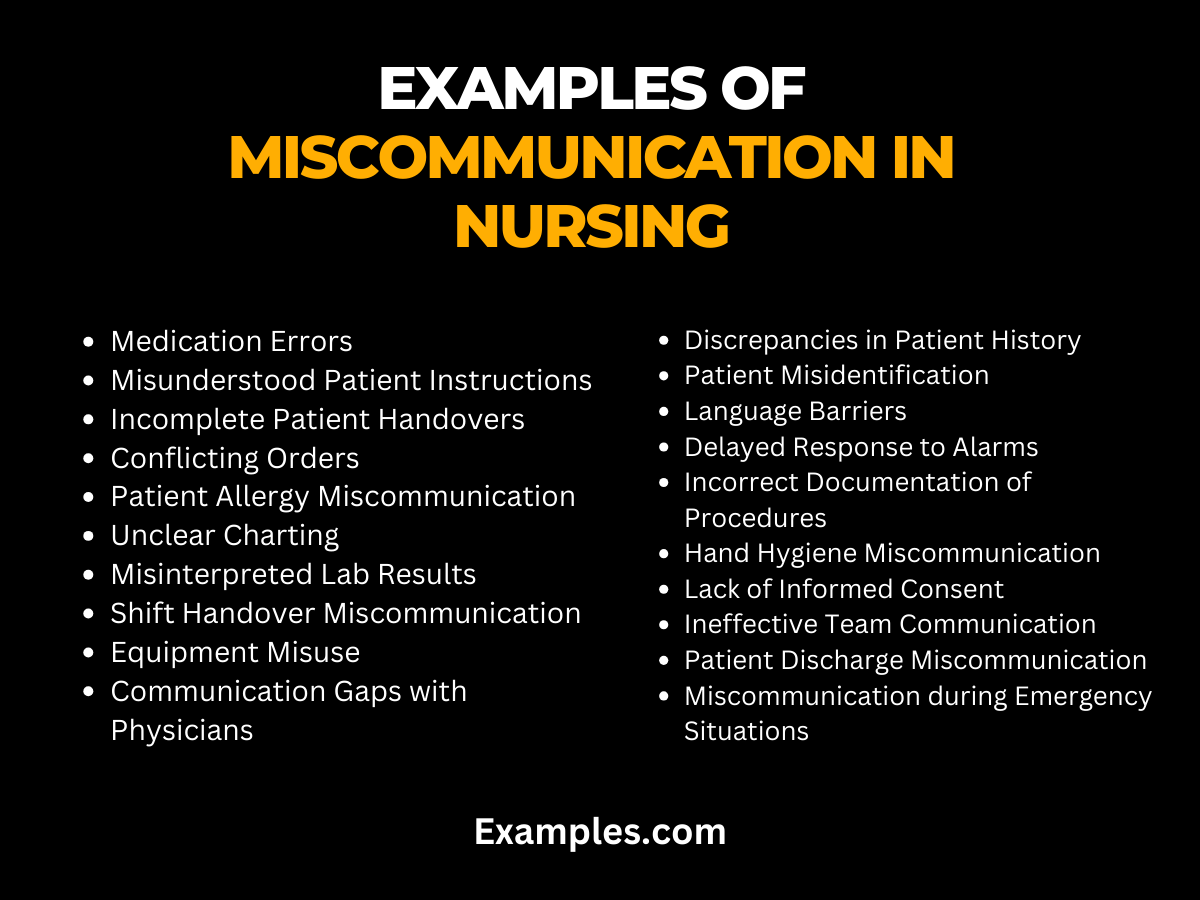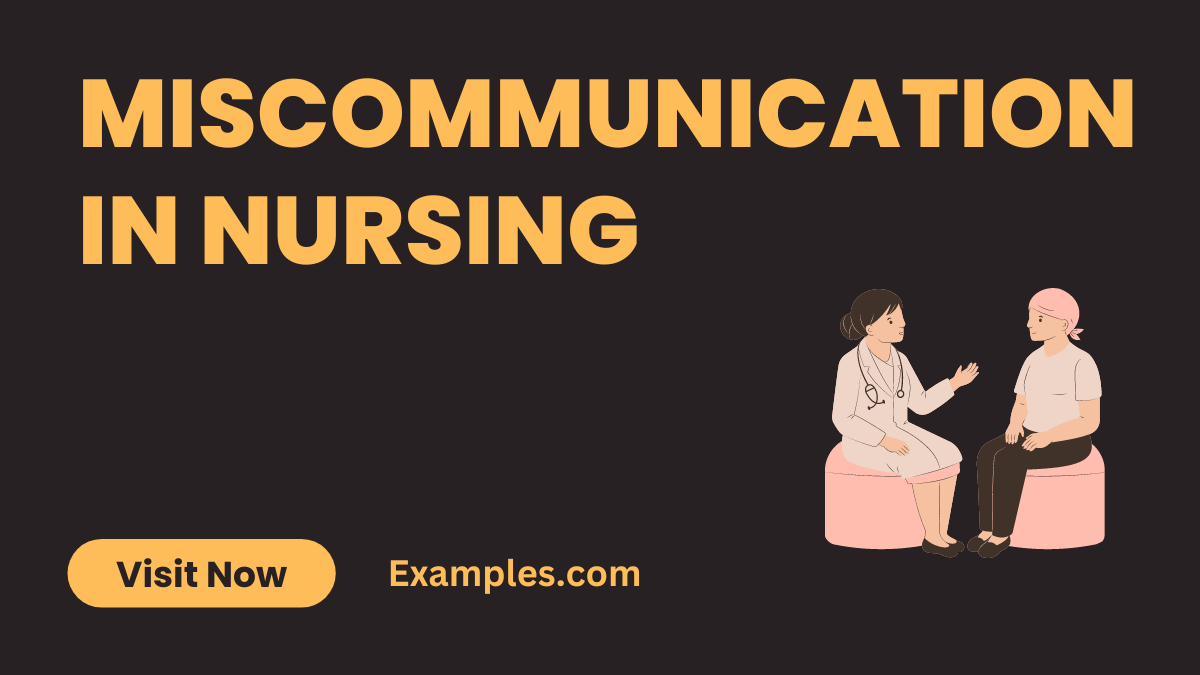19+ Miscommunication in Nursing Examples
Embark on a comprehensive exploration of miscommunication in nursing with our insightful guide, enriched with real-life examples. Delve into the complexities of healthcare communication, unraveling common pitfalls and providing actionable strategies. Navigate through practical communication examples to enhance your understanding, empowering healthcare professionals to foster clear and effective communication for improved patient care and teamwork.
What is Miscommunication in Nursing?

Miscommunication in nursing refers to instances where information is unclear, misunderstood, or inaccurately conveyed among healthcare professionals, potentially leading to errors in patient care. This breakdown in communication can occur at various levels, impacting the overall effectiveness of healthcare delivery. Recognizing and addressing miscommunication is critical for ensuring patient safety, fostering collaboration within the healthcare team, and enhancing the quality of nursing care.
What is the best Example of Miscommunication in Nursing?

In a healthcare setting, miscommunication about a patient’s medication can have serious consequences. Imagine a scenario where a nurse receives verbal instructions from a physician to administer a specific dosage of medication to a patient. However, due to unclear pronunciation or interpretation, the nurse administers the wrong dosage.
This miscommunication can lead to adverse effects on the patient’s health, highlighting the critical importance of precise communication in nursing to prevent such errors. Regular checks, clarification protocols, and standardized communication practices are crucial in mitigating the risks associated with medication-related miscommunication.
20 Examples of Miscommunication in Nursing

Explore 20 critical examples of miscommunication in nursing, unveiling the challenges within healthcare communication. From medication errors to misunderstood patient instructions, this guide provides valuable insights into common pitfalls. Gain a deeper understanding of the impact of miscommunication on patient care and discover practical strategies to enhance communication and teamwork within the nursing profession.
- Medication Errors:
- Avoidance: Implement standardized communication protocols.
- Correction: Establish double-check procedures for medication administration.
- Misunderstood Patient Instructions:
- Avoidance: Use clear and simple language.
- Correction: Encourage patients to repeat instructions for confirmation.
- Incomplete Patient Handovers:
- Avoidance: Standardize handover procedures.
- Correction: Include all relevant information in patient handovers.
- Conflicting Orders:
- Avoidance: Clarify conflicting orders immediately.
- Correction: Seek clarification from the ordering physician.
- Patient Allergy Miscommunication:
- Avoidance: Implement allergy communication standards.
- Correction: Double-check allergies and verify information with the patient.
- Unclear Charting:
- Avoidance: Establish clear charting guidelines.
- Correction: Review and update unclear chart entries promptly.
- Misinterpreted Lab Results:
- Avoidance: Provide clear documentation of lab results.
- Correction: Verify and cross-reference lab results for accuracy.
- Shift Handover Miscommunication:
- Avoidance: Standardize shift handover procedures.
- Correction: Include critical information in shift handovers.
- Equipment Misuse:
- Avoidance: Provide comprehensive equipment training.
- Correction: Re-educate staff on proper equipment use.
- Communication Gaps with Physicians:
- Avoidance: Establish open lines of communication.
- Correction: Seek clarification and provide updates to physicians.
- Discrepancies in Patient History:
- Avoidance: Cross-verify patient history details.
- Correction: Reassess and correct any discrepancies.
- Patient Misidentification:
- Avoidance: Implement strict patient identification protocols.
- Correction: Immediately correct any misidentification instances.
- Language Barriers:
- Avoidance: Provide language training for staff.
- Correction: Utilize interpreters for accurate communication.
- Delayed Response to Alarms:
- Avoidance: Implement prompt response protocols.
- Correction: Investigate and address the cause of the delay.
- Incorrect Documentation of Procedures:
- Avoidance: Standardize procedure documentation.
- Correction: Review and correct inaccuracies promptly.
- Hand Hygiene Miscommunication:
- Avoidance: Reinforce hand hygiene protocols.
- Correction: Provide immediate retraining on proper hand hygiene.
- Lack of Informed Consent:
- Avoidance: Implement thorough informed consent procedures.
- Correction: Obtain consent and document the process clearly.
- Ineffective Team Communication:
- Avoidance: Foster a culture of open communication.
- Correction: Conduct team communication workshops.
- Patient Discharge Miscommunication:
- Avoidance: Standardize discharge communication.
- Correction: Conduct follow-up calls to clarify instructions.
- Miscommunication during Emergency Situations:
- Avoidance: Establish clear emergency communication protocols.
- Correction: Conduct debriefs to address communication issues after emergencies.
How does miscommunication affect patient care?
19+ Miscommunication in Nursing Examples

Embark on a comprehensive exploration of miscommunication in nursing with our insightful guide, enriched with real-life examples. Delve into the complexities of healthcare communication, unraveling common pitfalls and providing actionable strategies. Navigate through practical communication examples to enhance your understanding, empowering healthcare professionals to foster clear and effective communication for improved patient care and teamwork.
What is Miscommunication in Nursing?

Miscommunication in nursing refers to instances where information is unclear, misunderstood, or inaccurately conveyed among healthcare professionals, potentially leading to errors in patient care. This breakdown in communication can occur at various levels, impacting the overall effectiveness of healthcare delivery. Recognizing and addressing miscommunication is critical for ensuring patient safety, fostering collaboration within the healthcare team, and enhancing the quality of nursing care.
What is the best Example of Miscommunication in Nursing?

In a healthcare setting, miscommunication about a patient’s medication can have serious consequences. Imagine a scenario where a nurse receives verbal instructions from a physician to administer a specific dosage of medication to a patient. However, due to unclear pronunciation or interpretation, the nurse administers the wrong dosage.
This miscommunication can lead to adverse effects on the patient’s health, highlighting the critical importance of precise communication in nursing to prevent such errors. Regular checks, clarification protocols, and standardized communication practices are crucial in mitigating the risks associated with medication-related miscommunication.
20 Examples of Miscommunication in Nursing

Explore 20 critical examples of miscommunication in nursing, unveiling the challenges within healthcare communication. From medication errors to misunderstood patient instructions, this guide provides valuable insights into common pitfalls. Gain a deeper understanding of the impact of miscommunication on patient care and discover practical strategies to enhance communication and teamwork within the nursing profession.
Medication Errors:
Avoidance: Implement standardized communication protocols.
Correction: Establish double-check procedures for medication administration.
Misunderstood Patient Instructions:
Avoidance: Use clear and simple language.
Correction: Encourage patients to repeat instructions for confirmation.
Incomplete Patient Handovers:
Avoidance: Standardize handover procedures.
Correction: Include all relevant information in patient handovers.
Conflicting Orders:
Avoidance: Clarify conflicting orders immediately.
Correction: Seek clarification from the ordering physician.
Patient Allergy Miscommunication:
Avoidance: Implement allergy communication standards.
Correction: Double-check allergies and verify information with the patient.
Unclear Charting:
Avoidance: Establish clear charting guidelines.
Correction: Review and update unclear chart entries promptly.
Misinterpreted Lab Results:
Avoidance: Provide clear documentation of lab results.
Correction: Verify and cross-reference lab results for accuracy.
Shift Handover Miscommunication:
Avoidance: Standardize shift handover procedures.
Correction: Include critical information in shift handovers.
Equipment Misuse:
Avoidance: Provide comprehensive equipment training.
Correction: Re-educate staff on proper equipment use.
Communication Gaps with Physicians:
Avoidance: Establish open lines of communication.
Correction: Seek clarification and provide updates to physicians.
Discrepancies in Patient History:
Avoidance: Cross-verify patient history details.
Correction: Reassess and correct any discrepancies.
Patient Misidentification:
Avoidance: Implement strict patient identification protocols.
Correction: Immediately correct any misidentification instances.
Language Barriers:
Avoidance: Provide language training for staff.
Correction: Utilize interpreters for accurate communication.
Delayed Response to Alarms:
Avoidance: Implement prompt response protocols.
Correction: Investigate and address the cause of the delay.
Incorrect Documentation of Procedures:
Avoidance: Standardize procedure documentation.
Correction: Review and correct inaccuracies promptly.
Hand Hygiene Miscommunication:
Avoidance: Reinforce hand hygiene protocols.
Correction: Provide immediate retraining on proper hand hygiene.
Lack of Informed Consent:
Avoidance: Implement thorough informed consent procedures.
Correction: Obtain consent and document the process clearly.
Ineffective Team Communication:
Avoidance: Foster a culture of open communication.
Correction: Conduct team communication workshops.
Patient Discharge Miscommunication:
Avoidance: Standardize discharge communication.
Correction: Conduct follow-up calls to clarify instructions.
Miscommunication during Emergency Situations:
Avoidance: Establish clear emergency communication protocols.
Correction: Conduct debriefs to address communication issues after emergencies.
How does miscommunication affect patient care?
Delayed Treatments:
Issue: Treatment delays.
Prevention: Establish clear treatment communication channels.
Misunderstandings in Medical Orders:
Issue: Misinterpreted medical orders.
Prevention: Standardize protocols for order clarification.
Incomplete Patient Handovers:
Issue: Omitted critical patient information.
Prevention: Prioritize standardized comprehensive handovers.
Equipment Misuse:
Issue: Improper use of medical equipment.
Prevention: Provide thorough equipment usage training.
Communication Gaps with Physicians:
Issue: Ineffective communication with physicians.
Prevention: Establish open lines of communication and regular updates.
Incorrect Documentation of Procedures:
Issue: Inaccurate procedure documentation.
Prevention: Standardize documentation and conduct regular audits.
Delayed Response to Alarms:
Issue: Delayed response to critical alarms.
Prevention: Implement prompt response protocols and continuous training.
Lack of Informed Consent:
Issue: Inadequate informed consent.
Prevention: Thoroughly educate patients and standardize consent procedures.
Language Barriers:
Issue: Communication challenges due to language barriers.
Prevention: Provide language training and use interpreters.
Patient Discharge Miscommunication:
Issue: Complications from discharge miscommunication.
Prevention: Standardize discharge communication and conduct follow-ups.
Miscommunication during Emergency Situations:
Issue: Ineffective communication compromising patient safety.
Prevention: Establish clear emergency protocols and conduct regular drills.
Understanding these impacts is vital for preventing project miscommunication from compromising patient care quality and safety.
How do you overcome communication errors?
Clear Protocols:
Define precise communication protocols to minimize misunderstandings.
Active Listening:
Cultivate active listening skills to enhance message comprehension.
Feedback Mechanisms:
Establish feedback loops for prompt clarification and confirmation.
Diversify Channels:
Use varied communication channels (written, verbal, visual) for clarity.
Clarify Expectations:
Communicate roles and expectations clearly to prevent confusion.
Ongoing Training:
Provide continuous training to improve communication skills.
Technology Integration:
Leverage technology for real-time information exchange.
Encourage Open Dialogue:
Foster an environment where team members freely express concerns.
Document Important Information:
Thoroughly document crucial details for consistency.
Learn from Mistakes:
Conduct reviews after errors, implementing corrective actions.
Why is miscommunication a healthcare barrier?
Patient Safety Concerns:
Miscommunication can lead to errors in diagnosis, treatment, or medication administration, jeopardizing patient safety.
Treatment Delays:
Lack of clear communication may result in delays in treatment, affecting timely medical interventions.
Incomplete Patient Information:
Miscommunication may lead to incomplete handovers, hindering a comprehensive understanding of a patient’s medical history and condition.
Medical Errors:
Inaccurate or misunderstood information can contribute to medical errors with potentially severe consequences.
Inefficient Care Coordination:
Poor communication disrupts the coordination of care among healthcare professionals, impacting the overall efficiency of healthcare delivery.
Patient Disengagement:
Ineffective communication may lead to misunderstandings with patients, causing disengagement and hindering collaborative decision-making.
Legal and Ethical Implications:
Miscommunication can have legal and ethical ramifications, especially if it results in adverse outcomes for patients.
Increased Healthcare Costs:
Addressing the consequences of miscommunication, such as medical errors, may lead to increased healthcare costs for corrective measures and legal proceedings.
Staff Burnout:
Continuous miscommunication challenges contribute to stress and burnout among healthcare professionals, affecting job satisfaction and performance.
Negative Impact on Patient Outcomes:
Ultimately, miscommunication acts as a significant barrier by negatively influencing patient outcomes, impairing the overall quality of healthcare delivery.
Why is communication important in nursing?
Patient-Centered Care:
Effective communication is paramount for understanding and addressing the unique needs and concerns of each patient, promoting personalized care.
Accurate Patient Assessment:
Clear communication ensures accurate information exchange, aiding in comprehensive patient assessments and diagnosis.
Care Coordination:
Communication among healthcare professionals enhances the coordination of care, ensuring seamless transitions between different phases of treatment.
Medication Safety:
Precise communication is crucial for accurate medication administration, reducing the risk of errors and adverse drug reactions.
Building Trust with Patients:
Open and transparent communication establishes trust between nurses and patients, fostering a positive and collaborative healthcare relationship.
Timely Intervention:
Effective communication enables timely recognition of changes in a patient’s condition, facilitating prompt interventions and preventing complications.
Patient Education:
Clear communication empowers patients with knowledge, enabling them to actively participate in their care and make informed decisions about their health.
Team Collaboration:
Communication is essential for effective collaboration among interdisciplinary healthcare teams, promoting cohesive and coordinated patient care.
Conflict Resolution:
Clear communication skills are vital for resolving conflicts and addressing disagreements among healthcare professionals, ensuring a harmonious work environment.
Ethical Decision-Making:
Communication is integral to ethical decision-making in nursing, especially when navigating complex situations and respecting patients’ autonomy and rights.
Positive Workplace Culture:
Effective communication contributes to a positive workplace culture, promoting a supportive and collaborative environment among healthcare professionals.
Adherence to Protocols:
Clear communication ensures that nursing protocols and standards are consistently followed, maintaining quality and safety in patient care.
Reduced Medical Errors:
Precise communication reduces the likelihood of misinterpretations and medical errors, enhancing patient safety.
Patient Satisfaction:
Positive communication experiences contribute to overall patient satisfaction, influencing their perception of the quality of care received.
Continuous Improvement:
Regular communication allows for feedback and continuous improvement in nursing practices, adapting to evolving healthcare needs and standards.
Navigate the complexities of miscommunication in nursing with our comprehensive guide. Through real-world examples, discover the critical impact on patient care and healthcare outcomes. Armed with practical insights, healthcare professionals can implement effective strategies to overcome communication challenges, ensuring clarity, precision, and ultimately, the delivery of high-quality and safe patient-centered care


